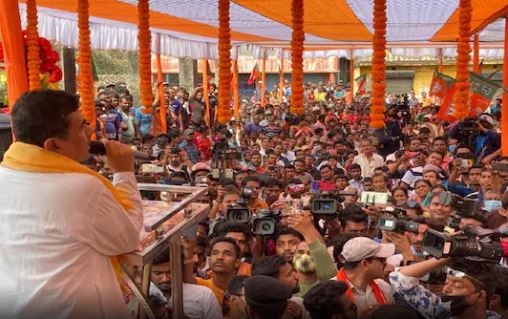
In 2001, the newly formed Trinamool Congress joined hands with parent Congress, with an aim to unseat the Left which was seeking re-election for the sixth term. Statistically, the alliance had a strong chance with roughly 40 per cent vote base and, with Mamata at the front, the sentiments were high. Slogans like “ebar, noy never” (this time or never) outlining the ‘golden opportunity’ filled the air. In the end, they had to remain satisfied with 86 seats (Trinamool 60, Congress 26) in total and the tag of ‘strong opposition’.
Something like this, but not entirely so, happened in the 2021 Assembly election in West Bengal. For a party that was nowhere near power till 2016 and promised to storm into the state secretariat, the BJP ended up with 77 of the 292 seats that went to polls. This is the largest haul by any opposition party in the state since 1996, when the Congress bagged 82 seats. The Trinamool Congress (TMC) too got more seats than ever. For the first time in the history of Bengal, the Left and the Congress will not be present in the state Assembly.
MAMATA’S EMPHATIC VICTORY
The victory was bigger for the TMC as it came against the formidable Modi-Shah combine. The 2001 election was contested on local issues. If the Congress-TMC blamed the Left for ‘misrule’, the Left too reminded them of the records of the past misrule (during Congress regime). In 2021, the BJP had the advantage of attacking the TMC on local issues, but the latter had a handicap. Since the BJP barely had an existence in the state until a few years ago, the TMC had to harp on national issues, in a local election.
In the end, Mamata won the contest emphatically. The Trinamool Congress not only got more seats but also five per cent more votes, as against a drop in the BJP’s vote share to 38 percent from the high of approximately 41 per cent in 2019 Lok Sabha polls. One can find many instances nationally—as in Delhi, Madhya Pradesh etc.—where the BJP’s performance varied between successive state and Lok Sabha elections. However, that will not explain Trinamool’s win fully.
Mamata not only enjoyed the support of Muslims, as is evident in her party’s unprecedented success in Malda, Murshidabad and North Dinajpur—having roughly 50-70 per cent Muslim votes—but also snatched a portion of the Scheduled Caste (mostly Matua vote) and tribal vote from the BJP. This has been crucial to Trinamool’s win in Jhargram and North and South 24 Parganas districts.
Interestingly, the Indian Secular Front (ISF) of Abbas Siddiqui did make a dent into Trinamool’s Muslim vote share in 24-Parganas districts, as is evident in the party’s win from Bhangar. But the gain of the Hindu votes helped the TMC neutralize the impact in these two districts, as seen in the party’s win in Amdanga. The Trinamool Congress won the seat with 42 per cent votes, despite the ISF taking away half (24 per cent) of the Muslim votes.
BJP HAS CARVED A SPACE
The results, therefore, came as a big setback for the BJP. The setback, however, is more in terms of optics. The party had gone all out in its attempt to win the state, naturally the loss has overshadowed the meteoric rise in the BJP’s seat share from three in 2016 to 77 in 2021. But fact remains that the BJP’s entry has changed the nature of Bengal politics. The BJP grew primarily as a result of the dilution of the Left vote share. The Left contested the 2021 polls (in coalition with the Congress and the ISF) with the hope of getting ‘their’ share of votes back but only to be left disappointed. ‘Left votes’ are now as much a history as the ‘Congress votes’.
And, that makes the political space of West Bengal both bipolar and open. The Leftist culture that had been the backbone of Bengal politics is seriously injured. The BJP is no more an alien in Bengal politics. Mamata Banerjee may have won the battle in 2021, but there are too many on the other side who wanted the BJP to win. Loyalties once lost, rarely return.
It’s all about time and opportunity. This year, Mamata reaped the harvest. Time may come when the Opposition will gain. The question is can the BJP utilize this opportunity. Politics is more about practice than theory. So, it will depend on how the BJP utilizes the opportunity of being the sole face of the Opposition. The Left and the Trinamool rode to power through political movements against the ruling dispensation. The BJP didn’t. This is the time to connect the dots.
WHAT BJP MUST DO NOW
However, before doing that, the BJP has to handle issues at home. In Tamil Nadu as well as in Kerala, the BJP has been building its base brick-by-brick. It might have remained unsuccessful in bagging a seat in Kerala, but the party looked more formidable than ever in 2021. By bagging seats in Tamil Nadu, it has finally made a dent in the heartland of Dravidian politics. It had a base at the organization level in Assam and select acquisitions from the rival camp like Himanta Biswa Sarma gave the party a distinct edge.
In West Bengal, the BJP neither had a strong organization nor was the acquisition policy successful. Just before the election, the party opened doors to outsiders and in many cases gave them priority over the old guard in ticket distribution. Not only the image of the party suffered due to inclusion of people with not-so-reputable background but the Trinamool built a counter narrative on the exclusion of rotten apples from the party. Except Suvendu Adhikari, most of these imported leaders from the TMC suffered heavy losses. Worse, the morale of the old guard who carried the flag till 2019 Lok Sabha polls is running low.
West Bengal BJP will not remain the same post-2021 election. Those who came for quick glory will soon vanish. The imported leaders or cadres may also explore greener pastures. And, all these are opportunities for the BJP to ready its organization for the upcoming elections in urban local bodies, panchayats etc. The Left gathered steam after 2001 and increased its vote share from roughly 45 per cent to 50 per cent in 2004 and 2006. Successful opposition by Mamata Banerjee saw them crumbling. The BJP failed to convert the momentum created in 2019 into a win in 2021. History will tell if it could play the role of a responsible opposition.





















